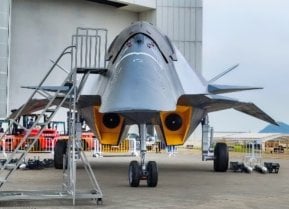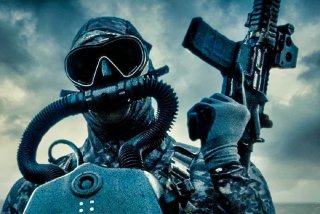What Makes SEAL Team 6 So Dangerous?
The U.S. Navy’s SEAL Team 6, now known as DEVGRU, is one of America’s most elite and storied special operations units.
What You Need to Know: The U.S. Navy’s SEAL Team 6, now known as DEVGRU, is one of America’s most elite and storied special operations units.

-Originally founded in 1980 after the failed Operation Eagle Claw, its rogue beginnings under Cmdr. Richard “Demo Dick” Marcinko laid the foundation for an unparalleled counterterrorism force. Today, DEVGRU comprises multiple specialized squadrons focusing on counterterrorism, close protection, and reconnaissance missions.
-Famous operations include the killing of Osama Bin Laden and high-profile hostage rescues. Equipped with cutting-edge weaponry, DEVGRU remains a global symbol of excellence in special operations.
In the spirit of (mostly) good-natured interservice rivalries, pundits can debate until they’re blue in the face about which unit in the U.S. Armed Forces’ Special Operations community is the most badass of the bunch.
But without a doubt, the U.S. Navy’s legendary SEAL Team 6 (aka Naval Special Warfare Development Group, DEVGRU) has to be at least very near the very top of that list.
SEAL Team 6’s Roguish Beginnings
SEAL Team 6 was officially founded in November 1980, in the waning days of the Jimmy Carter presidency, in the aftermath of Operation Eagle Claw aka “Desert One,” the horrifically failed attempt to rescue American hostages in Iran. The founding commanding officer of SEAL Team 6 was Commander Richard “Demo Dick” Marcinko, “The Rogue Warrior®,” who, even by unconventional warfare standards was a highly unconventional and extremely controversial spec warrior and leader.
In Demo Dick’s own words, penned in his bestselling autobiography Rogue Warrior: The Explosive Autobiography of the Controversial Death-Defying Founder of the U.S. Navy’s Top Secret Counterterrorist Unit- SEAL Team Six:
“[T]he U.S. Navy, in its infinite wisdom, had chosen me to design, build, equip, train, and lead what I now believed to be the most effective and highly secret counterterror force in the world—SEAL Team Six. Admiral Thomas Hayward, the chief of naval operations, gave me the order to create the unit himself … What the CNO had said to me was unequivocal: ‘Dick, you will not fail’… I took his words to heart. SEAL Team Six trained harder than any unit had ever trained before, waiting for the opportunity to show the skeptical bureaucrat-sailors and dip-dunk bean-counters prevalent in Washington that it was possible to fight back effectively against terrorists. I had cut more than a few corners and stepped on a shoe store full of toes. I had cut corners and stepped on a shoe store full of toes carrying out Admiral Hayward’s order.”
Indeed, under Marcinko’s command, SEAL Team 6 had a training ammunition budget higher than the training ammo budget for the entire U.S. Marine Corps! However, that “cut more than a few corners” bit eventually came back to bite old Demo Dick on his derriere; long story short, Marcinko was convicted of a conspiracy to defraud the government on January 24, 1990, sentenced to twenty-one months in federal prison, and fined $10,000. To his dying day, Dick maintained that he was the subject of a witch hunt, which he discusses in the final two chapters of his autobiography.
Life After Demo Dick: From ST6 to DEVGRU
Fast-forward to 1987, and SEAL Team 6 was disbanded, at least under that official moniker. Its role (with the exception of non-counterterrorism ship-boarding, which was given to the newly formed SEAL Team 8) was handed over to DEVGRU; however, this ostensibly “new” organization was in fact manned by (surprise, surprise) many old-school SEAL Team 6 operators and carried on with the same ethos and standard operating procedures.
Today, DEVGRU includes four assault squadrons (Blue, Red, Gold, Silver), one intelligence gathering squadron (Black), and one mobility/support squadron (Gray). Each line squadron contains around fifty sailors, and each squadron is divided into three troops. The troops will typically be divided into teams of assaulters and snipers. They have three primary missions:
· Counterterrorism (CT); focus on Maritime Counter Terrorism—e.g. hostage rescue and elimination of terrorists (euphemistically termed “tangos”) on ships, oil platforms, etc. - but is also capable of broader CT tasks.
· Close Protection
· Special Reconnaissance
DEVGRU’s most famous feat was, of course, the 2011 killing of Osama Bin Laden. Other successful DEVGRU operations that have been disclosed to the public include:
· The rescue of American hostages Jessica Buchanan and Dane Poul Hagen Thisted the Somali city of Adado—killing nine Somali pirates in the process—on January 25, 2012.
· The rescue of American doctor Dilip Joseph in Afghanistan on or about December 10, 2012.
Weapons of DEVGRU
· Handguns:
o Heckler & Koch HK45 “Mk 24 Mod. 0” .45 ACP
o SIG Sauer P226 “P226R Mk 25” 9×19mm
o Glock 19 9×19mm
o SIG Sauer P320 (M17/M18) 9×19mm
· Carbines:
o Noveske 10.5” NSR 5.56×45mm
o Heckler & Koch HK416 5.56×45mm (according to many accounts, this was the specific weapon used to bag Bin Laden)
o HK MP7 4.6×30mm (0.183 in (this may sound awfully diminutive from a stopping power standpoint, but the smaller cross-section of the round enables it to penetrate modern body armor with steel-core ammunition; moreover, the geometry of the bullet with its rear center of gravity ensures that the projectile rolls over in the target and releases most of its energy there, thus reducing the risk of overpenetration and endangerment of innocent bystanders)
o Colt Mk 18 CQBR 5.56×45mm
· Sniper and anti-material rifles:
o Colt Mk 12 SPR 5.56×45mm
o Knight’s Armament Company SR-25 7.62×51mm
o Remington Model 700 “Mk 13 Mod. 5” .300 Winchester Magnum
o McMillan Firearms TAC-338 .338 Lapua
o McMillan TAC-50 “Mk 15 Mod. 0” .50 BMG
o Barrett M107A1 .50 BMG
A hearty “HOOYAH” to SEAL Team 6/DEVGRU!
About the Author: Christian D. Orr
Christian D. Orr is a Senior Defense Editor for the National Security Journal (NSJ). He is a former Air Force Security Forces officer, Federal law enforcement officer, and private military contractor (with assignments worked in Iraq, the United Arab Emirates, Kosovo, Japan, Germany, and the Pentagon). Chris holds a B.A. in International Relations from the University of Southern California (USC) and an M.A. in Intelligence Studies (concentration in Terrorism Studies) from American Military University (AMU). He has also been published in The Daily Torch, The Journal of Intelligence and Cyber Security, and Simple Flying. Last but not least, he is a Companion of the Order of the Naval Order of the United States (NOUS).
Image Credit: Creative Commons.


